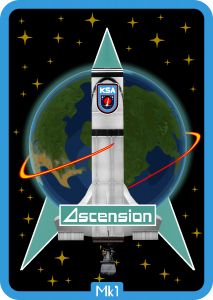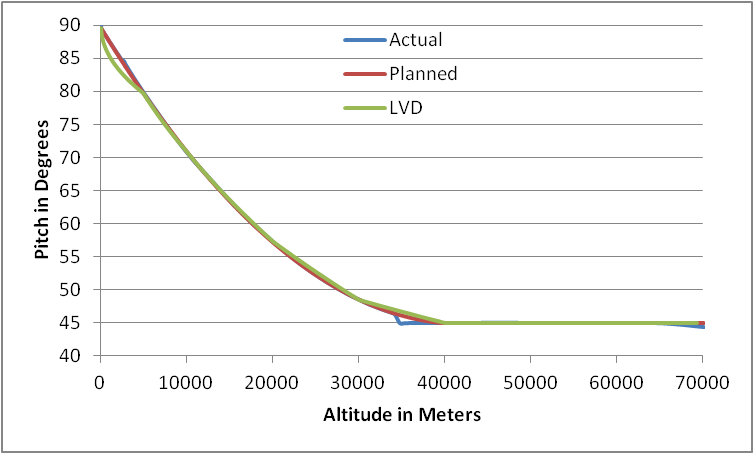 The second kerbed mission would see Commander Valentina become the second kerbal to venture up into space. Lessons learned both from Specialists Bill’s flight and the more recent unkerbed Mk1 mission were applied to the mission planning to make this the most on-target ascent to date for the Ascension Mk1. In the weeks leading up to the launch Val and her backup crew member Captain Jebediah trained together for the mission and in the days leading up to the launch they both were sequestered inside the Astronaut Complex as per the quarantine protocol that was established with the first kerbed mission. This once again helped to ensure the astronauts remained healthy, allowed medical doctors to draw baseline observations and gave both crew some much-needed downtime. Come launch day, both were refreshed and ready. Jeb remained suited up on standby while Val boarded the capsule and was ultimately not required to replace her for the mission as pre-launch operations proceeded smoothly.
The second kerbed mission would see Commander Valentina become the second kerbal to venture up into space. Lessons learned both from Specialists Bill’s flight and the more recent unkerbed Mk1 mission were applied to the mission planning to make this the most on-target ascent to date for the Ascension Mk1. In the weeks leading up to the launch Val and her backup crew member Captain Jebediah trained together for the mission and in the days leading up to the launch they both were sequestered inside the Astronaut Complex as per the quarantine protocol that was established with the first kerbed mission. This once again helped to ensure the astronauts remained healthy, allowed medical doctors to draw baseline observations and gave both crew some much-needed downtime. Come launch day, both were refreshed and ready. Jeb remained suited up on standby while Val boarded the capsule and was ultimately not required to replace her for the mission as pre-launch operations proceeded smoothly.
The Flight
The scheduled launch at 13:10 local time was met with a good ignition of the K2-X lifter engine, producing 125kN of thrust to push the rocket gently off the pad at 1.2 TWR, taking 3 seconds to rise up and clear the service towers before throttling up to near full thrust to hold a TWR of 1.65 for a comfortable ascent. At this time also the guidance routine kicked in to roll the rocket on a heading of 54° while beginning to pitch over and head downrange. Aboard, Val was dutifully calling out regular readings from her instruments so ground controllers could ensure that everything was operating correctly.
The ride up continued smoothly through MaxQ of 19.685kPa as the rocket passed through 6.7km ASL and 5 seconds later at L+0:53 exceeded Mach 1. As the rocket continued to power through the transonic regime the ride got a little bumpy thanks to some minor upper-atmospheric turbulence but it was nothing the control surfaces and guidance routines could not handle, holding the rocket on course and pitch. Val was at this time only experiencing 1.5Gs and despite the rattling was able to stay focused on her instruments, which continued to report a nominal ascent, confirmed by ground controllers.
The next major ascent milestone was reached at L+2:06 when the rocket passed through 40km, above the majority of the atmosphere and at a point where excess speed would not create any unwanted friction heating. Here the engine throttled from 41% all the way up to full, pushing Val back in her seat with an initial force of 3.6Gs. This was done to ensure that the rocket would burn through all its fuel before exiting the atmosphere and allowing the control surfaces to hold the nose at the proper pitch due to a slight unbalance to the center of mass that occurs as the tanks empty due to the pitched fins.
MECO came at L+2:35, relieving Val of the Gee forces that had built up to 5.1Gs by this time, which she found to be fairly uncomfortable if manageable. The burnout occurred only 3km short of the targeted altitude and the rocket coasted out of the atmosphere 6 seconds later. 4 seconds after that at L+2:44 the capsule was automatically separated from the lift stage and pushed away via the Reaction Control System thrusters for another 10 seconds before the automated guidance shut down and turned over command of the capsule to Val.
Unlike Bill’s mission, Val now had proper full control over the capsule guidance and was able to activate the Stability Assist System to orient the capsule in various directions, although her first objective was a manual flip-over of the pod so she could spot the lift stage out the window and confirm that she was in fact well clear and the two were slowly separating to be far enough apart come re-entry. Once that was confirmed, Val was able to unstrap for a closer look out the window and had full freedom in which way to orient the capsule to observe the planet falling away below as she climbed towards an apokee of 251.907km.
By the time she reached apokee at L+8:11 she had already spent more time in space than Bill had. She continued to make observations out the capsule window until Specialist Bob, working CapCom, told her she needed to return to her seat and strap in to prepare for re-entry. This was of course done several minutes in advance so she could properly prepare the controls and orient the capsule retrograde so her heat shield was facing downwards. Rolling the capsule “up” in this orientation presented her with a view of the stars while ensuring her return position, butt-down, would provide the best comfort for the upcoming rough ride. Unlike Bill, she was coming in from higher and with more speed.
There was some minor concern about that fact that while orienting for re-entry Val was still able to make visual contact with the lift stage our her window. If they were too close, there was a chance the lifter could collide with her capsule with catastrophic results. Ground control asked her to specify just how big or small the stage visually appeared and when she told them it was only just barely visible they told her there was no need to expend further propellant to maneuver further away.
Atmospheric interface was breached at L+13:42 while traveling at 1.9km/s and Val’s capsule would continue to accelerate to just over 2km/s, producing a peak period in excess of 10Gs for 5 seconds, during which Val had to endure as much as 11.4Gs. Temperature inside the capsule remained below 80°F (26.6°C) while the air outside the heat shield reached 2,541°F (1,394°C), causing ionized plasma to form around the capsule which resulted in a radio blackout that lasted 33 seconds.
Shortly after getting back in contact with KSC, Val confirmed that terminal velocity had further arrested her descent rate and her Launch Escape System tower had jettisoned to allow her chutes to pre-deploy in their reefed state at L+14:36, 12km ASL. She continued to plummet towards the surface, roughly only 35km away from the target landing zone, until passing through 1km her chutes expanded to their full deployment and brought her down to a descent rate of just over 5m/s. Almost two minutes later she splashed down safely into the waters east of Ockr at L+17:52, 687km downrange from KSC. The recovery ship MSV Aldeny was in the area to pull her out of the water shortly thereafter, also recovering the heat shield floating nearby.
Flight Analysis
Ascent Profile
The major highlight of this mission was the near-perfect ascent of the rocket in sticking to the programmed pitch profile, the best flight we have had to date. There were just three main issues that brought the rocket up short of its planned trajectory:
First, note the deviation of the green line in the beginning and towards the end of the curve. The deviation at the start was something we had known about from the last launch and thought we had fixed in the modeling of this ascent. The deviation towards the end of the curve prior to the pitch hold is because the ascent profile in Launch Vehicle Designer was too broad at the end, going from 20 to 30 to 40km with too much of a pitch change to create a smoother curve.
The second mistake was being overly-conservative in our guidance routine for locking pitch of the rocket. This was another problem we had hoped to fix from the last flight, which overshot the pitch hold because the guidance code waited until the rocket reached the pitch target before telling it to hold there. With the thin air affecting control authority it was too late to hold pitch-over. This time we wanted the hold to go into effect before the target was reached but did so way too early, anticipating the controls would have less of an effect.
The final mistake was an oversight from when the original mission plan was changed after discovering the mass unbalance the previous flight. The rocket was supposed to burn out of the atmosphere, not within it and so code to unlock the guidance was included in the MECO routine. This was not removed when the mission was changed to burn out within the atmosphere, and so in the few seconds remaining before reaching space the angled fins caused the rocket to nose down slightly off the pitch profile.
One other problem not visible in the above plot that was only recently identified in the analysis leading up to this report is that Launch Vehicle Designer does not seem to be properly calculating the Thrust to Weight Ratio (TWR) of the engine, which could be the most serious cause for the trajectory deviation. We are working closely with the LVD maintainer to find and correct this issue so future launches that use the TWR throttle model can be more accurate.
High Crew G Loading
Val had the slightly unpleasant privilege of experiencing the greatest sustained G-force of any crew during the course of her mission, both during ascent and descent. In fact we created a new record for it. Thanks to the recent research carried out by Dr. Murstap’s rocket sled runs, we allowed the mission design to be altered not only for burning out the engine in atmosphere and creating high Gs on ascent but traveling up to a higher apokee, in turn causing greater Gs on re-entry. In both instances Val said she found the experience highly uncomfortable but manageable for the short periods she had to endure them. She still wishes she had a way to train for forces like these and the request has been passed up to management to see if we can’t construct a facility that would allow for such a thing.
Future Plans
All three of the ascent guidance errors will be corrected and hopefully by the time of the next launch we will have an updated version of LVD to properly calculate the TWR value during ascent.
The next mission will see Captain Jebediah assume command of the capsule, with Specialist Bob as his backup. They have already begun basic mission training and helped to work on this analysis. Ascension team leads will gather later today to discuss the launch date for the next mission and we will have an announcement tomorrow.
Enjoy this video of the mission!








